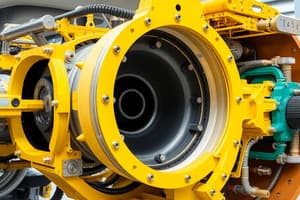Podcast
Questions and Answers
What is the primary purpose of practical hydraulic systems in modern aircraft?
What is the primary purpose of practical hydraulic systems in modern aircraft?
To transmit power from one place to another
According to Pascal's Law, what happens to the increase in pressure on a confined liquid?
According to Pascal's Law, what happens to the increase in pressure on a confined liquid?
It is transmitted equally and undiminished to all parts of the container
What is the unit of measurement for pressure in the imperial system?
What is the unit of measurement for pressure in the imperial system?
Pounds per square inch (PSI)
What type of pump is typically used in modern aircraft hydraulic systems?
What type of pump is typically used in modern aircraft hydraulic systems?
What is the purpose of an actuator in a hydraulic system?
What is the purpose of an actuator in a hydraulic system?
What is the function of a valve in a hydraulic system?
What is the function of a valve in a hydraulic system?
What is the benefit of using hydraulic systems in aircraft compared to electric or pneumatic systems?
What is the benefit of using hydraulic systems in aircraft compared to electric or pneumatic systems?
What is the purpose of an accumulator in a hydraulic system?
What is the purpose of an accumulator in a hydraulic system?
What is the formula to compute power in a hydraulic system?
What is the formula to compute power in a hydraulic system?
What is the advantage of hydraulic systems over other mechanical systems?
What is the advantage of hydraulic systems over other mechanical systems?
How does the size of pistons affect mechanical advantage in a hydraulic system?
How does the size of pistons affect mechanical advantage in a hydraulic system?
What happens when a piston with an area of one square inch moves one inch in a hydraulic system?
What happens when a piston with an area of one square inch moves one inch in a hydraulic system?
What is the purpose of an accumulator in a hydraulic system?
What is the purpose of an accumulator in a hydraulic system?
How is the flow rate of a hydraulic system typically measured?
How is the flow rate of a hydraulic system typically measured?
What is the unit of measurement for pressure in a hydraulic system?
What is the unit of measurement for pressure in a hydraulic system?
What is the role of a valve in a hydraulic system?
What is the role of a valve in a hydraulic system?
What is the fundamental principle behind hydraulic systems, and how does it generate power?
What is the fundamental principle behind hydraulic systems, and how does it generate power?
What is the primary function of a hydraulic filter, and how does it affect system performance?
What is the primary function of a hydraulic filter, and how does it affect system performance?
What is the purpose of an accumulator in a hydraulic system, and how does it benefit system operation?
What is the purpose of an accumulator in a hydraulic system, and how does it benefit system operation?
What is the role of an actuator in a hydraulic system, and how does it convert fluid power into mechanical energy?
What is the role of an actuator in a hydraulic system, and how does it convert fluid power into mechanical energy?
What is the primary function of a valve in a hydraulic system, and how does it control fluid flow?
What is the primary function of a valve in a hydraulic system, and how does it control fluid flow?
What is the primary purpose of the high pressure relief valve in a hydraulic system?
What is the primary purpose of the high pressure relief valve in a hydraulic system?
What are the key differences between hydraulic and pneumatic systems, and how do these differences affect system operation?
What are the key differences between hydraulic and pneumatic systems, and how do these differences affect system operation?
What is the significance of Pascal's Law in the operation of hydraulic systems, and how does it relate to fluid power transmission?
What is the significance of Pascal's Law in the operation of hydraulic systems, and how does it relate to fluid power transmission?
How does the accumulator help in case of an engine or pump failure in a hydraulic system?
How does the accumulator help in case of an engine or pump failure in a hydraulic system?
What is the importance of mechanical advantage in hydraulic systems, and how does it relate to system performance?
What is the importance of mechanical advantage in hydraulic systems, and how does it relate to system performance?
What is the function of the accumulator in a hydraulic system, apart from supplying fluid in case of a failure?
What is the function of the accumulator in a hydraulic system, apart from supplying fluid in case of a failure?
What is the significance of the pressure gauge in a hydraulic system?
What is the significance of the pressure gauge in a hydraulic system?
What type of device is directly fitted to a flight control in a hydraulic system, as shown in Figure 3?
What type of device is directly fitted to a flight control in a hydraulic system, as shown in Figure 3?
What is the role of the power source in a hydraulic system?
What is the role of the power source in a hydraulic system?
How does the movement of the small piston affect the large piston in a hydraulic system?
How does the movement of the small piston affect the large piston in a hydraulic system?
What are the three essential components that a hydraulic system must have?
What are the three essential components that a hydraulic system must have?
What is the primary function of pumps in a hydraulic system?
What is the primary function of pumps in a hydraulic system?
What type of pumps are used as an additional source of power for some hydraulic systems?
What type of pumps are used as an additional source of power for some hydraulic systems?
What is the difference between single acting and double acting hand pumps?
What is the difference between single acting and double acting hand pumps?
Why is it necessary to release all the air pressure before servicing or performing maintenance on a pressurised reservoir?
Why is it necessary to release all the air pressure before servicing or performing maintenance on a pressurised reservoir?
What is the purpose of replenishing a pressurised reservoir in a hydraulic system?
What is the purpose of replenishing a pressurised reservoir in a hydraulic system?
What is the purpose of an accumulator in a hydraulic system, according to the text?
What is the purpose of an accumulator in a hydraulic system, according to the text?
What is the relation between pumps and pressure in a hydraulic system?
What is the relation between pumps and pressure in a hydraulic system?
Why is it important to refer to the specific maintenance manual for the correct replenishment procedure of a pressurised reservoir?
Why is it important to refer to the specific maintenance manual for the correct replenishment procedure of a pressurised reservoir?
Flashcards
Hydraulic System
Hydraulic System
Pressurized liquid used to generate, control, and transmit power.
Pascal's Law
Pascal's Law
Any increase in pressure on a confined liquid is transmitted equally.
Force
Force
Energy exerted causing motion or change.
Pressure
Pressure
Signup and view all the flashcards
Mechanical Advantage
Mechanical Advantage
Signup and view all the flashcards
Basic Hydraulic System
Basic Hydraulic System
Signup and view all the flashcards
Pumps
Pumps
Signup and view all the flashcards
Hand Pumps
Hand Pumps
Signup and view all the flashcards
Hand Pump Functions
Hand Pump Functions
Signup and view all the flashcards
Single-acting and double-acting
Single-acting and double-acting
Signup and view all the flashcards
Study Notes
Hydraulic Systems Introduction
- Hydraulic systems use pressurized liquid to generate, control, and transmit power
- They are used in aircraft, including landing gear and flight control systems
- Hydraulic systems belong to the branch of physics known as fluid power systems
- They do their work by moving fluid, which is incompressible
Pascal's Law
- States that any increase in pressure on a confined liquid is transmitted equally and undiminished to all parts of the container
- Acts at right angles to the enclosing walls of the container
- Pressure is expressed in pounds per square inch (PSI) or grams per square centimeter (g/cm2)
Force and Pressure
- Force is energy exerted or brought to bear, causing motion or change
- Expressed in pounds or metric terms of grams (g) or kilograms (kg)
- Pressure is force applied over a given area
- Expressed in pounds per square inch (PSI) or grams per square centimeter (g/cm2)
Mechanical Advantage
- Ratio of output force to input force applied to a mechanism
- Hydraulic systems have a large gain in mechanical advantage made possible by varying the size of pistons
- Example: a piston with an area of 1 square inch pressing down with a force of 1 pound will produce a pressure of 1 psi, and a larger piston with an area of 20 square inches will produce a force of 20 pounds
Basic Hydraulic System
- A hydraulic system must have a source of power, a means of transmitting this power, and a device to use the power
- Consists of a power source (e.g. engine-driven pump), a transmission medium (e.g. hydraulic fluid), and an actuator (e.g. landing gear or flight control)
- Includes a pressure gauge, high-pressure relief valve, and accumulator
Pumps
- Fluid power is only available to an aircraft hydraulic system when that fluid is moved under pressure
- Pumps are fluid movers; they generate the flow of fluid under pressure
- Types of pumps used in hydraulic systems: hand pumps, power-driven pumps
Hand Pumps
- Used as an additional source of power for some hydraulic systems
- Used to provide fluid under pressure, operate subsystems, and charge system accumulators with oil
- Used for emergency operations and ground handling of the aircraft
- Two types: single-acting and double-acting
Studying That Suits You
Use AI to generate personalized quizzes and flashcards to suit your learning preferences.



